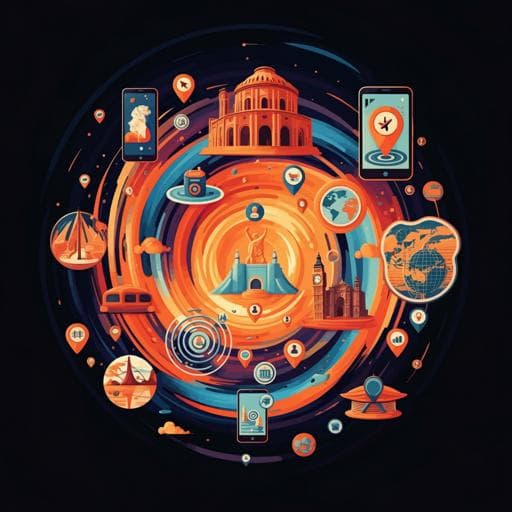
Business
The conceptualization of smart tourism service platforms on tourist value co-creation behaviours: an integrative perspective of smart tourism services
C. Chuang
This research by Chung-Ming Chuang delves into the innovative realm of smart tourism service platforms, introducing a validated 32-item scale that measures smart services in various sectors like transportation and accommodations. Explore how this study links tourist behavior and technology to sustainable value creation in tourism!
~3 min • Beginner • English
Introduction
The study addresses how to integrate core smart tourism service (STS) measures on a platform to facilitate tourist value co-creation sustainably. Grounded in service-dominant (S-D) logic, the paper positions STS within a smart tourism ecosystem where tourists, firms, and governments interact via ICT-enabled platforms (apps/websites) to deliver information-rich, personalized, real-time services. Existing research often focuses on single sectors, leaving a gap in holistic, cross-sector STS frameworks and measures. The purpose is to develop an integrative, multidimensional STS scale spanning key tourism sectors and to conceptualize an STS platform that links ICT functions, information services, tourist applications/behaviours, and sustainable value co-creation across pre-, during-, and post-trip phases.
Literature Review
The paper synthesizes smart tourism concepts across three pillars: Smart Technology (ICT-supported integration of tourism resources, sensors, mobile devices enabling real-time data), Smart Tourism Experience (technology-mediated, personalized, context-aware, real-time services), and Smart Business Ecosystem (networked stakeholders co-creating value via platforms, AI, and social media). S-D logic underpins value co-creation in service ecosystems, emphasizing actor networks, resource integration, and co-production. A smart tourism ecosystem is framed as a platform enabling information sharing, connectivity, and value co-creation across pre/during/post-trip. Fundamental ecosystem service elements are identified as attractions, transportation, accommodation, diet, and purchase, with payment emerging as an additional key element. Prior works highlight benefits and challenges in each sector (e.g., smart guides at attractions, ITS for transport, ICT-enabled hotel operations, mobile ordering in dining, e-/m-commerce in purchasing) but lack an aggregate measurement framework. The paper proposes that integrating these elements via an STS platform enables the pathway from STS to tourist behaviours to sustainable value co-creation.
Methodology
An exploratory sequential mixed-method design with seven stages was implemented to develop and validate an STS scale and derive a conceptual platform framework. Study 1 (qualitative): Stage 1—Item generation via systematic literature review (83 articles across major databases; 2000–2020; English; SSCI/SCI) and Fuzzy Delphi expert interviews (n=17; tourism and Internet/e-commerce experts). Initial pool: 68 items. Two Delphi rounds applied geometric mean (G), quartile deviation (Q), thresholds (e.g., G<3.5; Q1<3 and Q3<4), and Kruskal–Wallis tests to refine items; 10 items removed after round two. Stage 2—Item purification through expert review: removal of 10 items, merging 12 into 6, adding 2; resulting in 54 items; trimmed to 44 items for survey after Delphi. Study 2 (quantitative—EFA): Stage 3—Dimensionality determination using tourist surveys in Taipei City. Pretest (n=90) led to deletion of 5 items (low CITC or nonsignificant CR). Main survey (n=379) collected on-site at attractions (convenience sampling with checks for group bias). Psychometrics: KMO=0.95; Bartlett’s χ2=8692.21, p<0.001. PCA with varimax rotation, eigenvalue>1, minimum three items per factor; dropping items with loadings <0.50 or cross-loading >0.50. Result: six-factor, 32-item solution explaining 69.6% variance; Cronbach’s alpha for each factor >0.70. Study 3 (quantitative—CFA/SEM): Stage 4—Scale validation with 815 questionnaires (mix of Taipei on-site and online pre-travellers via snowball through agencies), split randomly into calibration (n=410) and validation (n=405) samples. CFA (AMOS) showed significant standardized loadings (p<0.001); composite reliability >0.80; acceptable fit indices: calibration χ2/df=2.67, CFI=0.92, TLI=0.91, RMSEA=0.06, SRMR=0.05; validation χ2/df=2.97, CFI=0.91, TLI=0.90, RMSEA=0.07, SRMR=0.05. Second-order models suitably replaced first-order models (fit comparable; Table 9). Discriminant validity established (Table 10). Stage 5—Common method bias assessed via procedural remedies and Harman’s single-factor test; single factor explained 44% and 43% variance, suggesting minimal bias. Stage 6—Measurement invariance across travel phases (pre-travel vs during-trip) supported (no significant differences between constrained/unconstrained models; Table 11). Stage 7—Nomological and construct validity via second-order structural equation modeling; squared multiple correlations indicated substantial variance explained by higher-order STS factor for each dimension.
Key Findings
- Developed and validated a 32-item, six-dimension Smart Tourism Service (STS) scale: smart attraction, transportation, accommodation, diet, purchase, and payment services. - EFA results (n=379): six factors explaining 69.61% variance; factor alphas: attraction (α=0.887), transportation (α=0.895), accommodation (α=0.819), diet (α=0.904), purchase (α=0.929), payment (α=0.869). - CFA results (n=410/405): good model fits. Calibration: χ2/df=2.67, CFI=0.92, TLI=0.91, RMSEA=0.06, SRMR=0.05. Validation: χ2/df=2.97, CFI=0.91, TLI=0.90, RMSEA=0.07, SRMR=0.05. Composite reliability for all dimensions >0.80; AVE broadly acceptable; discriminant validity supported. - Second-order STS factor structure validated; second-order model fit comparable to first-order (e.g., validation second-order χ2/df=2.94, CFI=0.90, TLI=0.90, RMSEA=0.07, SRMR=0.06). - Squared multiple correlations (second-order CFA): attraction 72%, transportation 68%, accommodation 49%, diet 81%, purchase 69%, payment 71%. - Measurement invariance across travel phases (pre-travel vs during-trip) supported (non-significant differences across constrained/unconstrained models; ΔCFI≈0, ΔTLI≈0; Table 11). - Common method bias minimal (single factor explained 44% and 43%). - The scale clarifies tourist-operated technologies and services and supports a conceptual STS platform linking ICT functions, information services, applications, tourist behaviours, and sustainable value co-creation. - Conceptual pathway posited: STS → behaviour → sustainable value co-creation (economic, socio-cultural, environmental).
Discussion
Findings converge on a robust six-dimensional structure of STS that maps to core tourism sectors. The validated second-order scale demonstrates that tourists assess smart services holistically across attraction, transport, accommodation, diet, purchase, and payment. This supports S-D logic by evidencing value co-creation through technology-mediated interactions across pre-, during-, and post-trip phases. The STS platform conceptualization positions ICT-enabled information generation, transmission, and processing as the foundation for applications (e.g., weather, queues, traffic, e-maps, booking, ordering, payments) that shape tourist behaviours (planning, reserving, navigating, purchasing, paying, and sharing). These behaviours, in turn, contribute to sustainable value co-creation: economic (cost/time efficiency), socio-cultural (access, comfort, experience sharing), environmental (reduced energy use, guidance about environmental challenges). Sector-specific insights include the need for real-time, location-aware attraction guides; ITS for both self- and public transport; ICT-enabled hospitality operations (self-service check-in, mobile booking, smart room access); smart dining (mobile ordering, queue systems, cloud feedback); and distinctions between purchase (utility-based engagement) and payment (methods/means). The invariance results imply the scale’s applicability across travel phases, enabling practitioners to profile demands and predict behaviours regardless of timing. Overall, the scale underpins a conceptual platform that aligns supply-side ICT capabilities with demand-side behavioural support, reinforcing the STS → behaviour → sustainable value co-creation mechanism.
Conclusion
This study develops and validates a comprehensive, second-order, six-dimensional STS scale and uses it to conceptualize an STS platform grounded in S-D logic and a smart tourism ecosystem perspective. The platform integrates core service measures (attraction, transportation, accommodation, diet, purchase, payment) and links ICT functions to tourist applications and behaviours that drive sustainable value co-creation. Empirical evidence across multiple stages (Delphi, EFA, CFA, invariance) supports the scale’s reliability and validity and its predictive structure. The work bridges a gap in holistic STS measurement and platform conceptualization and offers theoretical and managerial guidance for integrating smart services. Future research should validate the scale across different smart cities and user segments, explore moderators (e.g., smart experience, information exposure, literacy), examine technology variants (smartphones, wearables), and assess phase-specific STS alternatives and cross-sector integration, especially in contexts affected by disruptions such as COVID-19.
Limitations
- The STS scale is generic and may over-universalize sector realities; perceptions can vary by smart city context and respondent characteristics. - Validation is focused on Taipei and specific samples; broader cross-cultural and cross-destination validations are needed. - Further research should test utility across diverse tourist typologies (e.g., backpackers, volunteers), different smart technologies, and identify moderators (smart experiences, information exposure, literacy) and outcomes. - Stage of travel likely alters service demands; future work should examine phase-specific STS alternatives and cross-sector integration, considering post-pandemic behavioural shifts.
Related Publications
Explore these studies to deepen your understanding of the subject.







